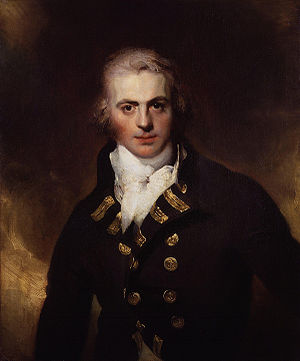Graham Moore (Royal Navy officer)
Graham Moore | |
|---|---|
 Oil on canvas portrait, c. 1792, by Sir Thomas Lawrence | |
| Born | 1764 Glasgow, Scotland |
| Died | 1843 |
| Allegiance | Kingdom of Great Britain Great Britain and Ireland |
| Service/ | Royal Navy |
| Years of service | 1777-1839 |
| Rank | Admiral |
| Battles/wars | French Revolutionary Wars Napoleonic Wars |
| Relations | Dr. John Moore General Sir John Moore |
Admiral Sir Graham Moore, GCB, GCMG (1764–1843) was a British sailor and a career officer in the Royal Navy. He was the younger brother of General Sir John Moore.
Moore was born in Glasgow, Scotland, the son of the doctor and author John Moore, and Jean Simson. He entered the Navy in 1777[1] at the age of 13, gaining promotion to Lieutenant in 1782.[1] He was made Post-Captain in 1794,[1] soon after the start of the Revolutionary War, commanding the 36 gun frigate HMS Melampus from 1800, before being appointed to HMS Indefatigable (44) in 1803.[1]
Moore commanded the squadron of four Royal Navy frigates - Indefatigable (44), Medusa (32), Lively (38) and Amphion (32) - that captured a Spanish treasure fleet of four frigates - Medea (40), Clara (34), Fama (34) and Mercedes (36) - carrying bullion from the Caribbean back to Spain off Cadiz in the Action of 5 October 1804.[1]
Moore was then attached to Sir Robert Calder's squadron blockading Ferrol. In 1808, he served as Commodore, flying his broad pendant in the new ship HMS Marlborough[1] assisting Admiral Sir Sidney Smith with the Portuguese royal family's escape to Brazil. He later served as part of the North Sea fleet for several years. He was promoted to Rear-Admiral in 1812,[1] and became Second-in-Command, Mediterranean Fleet in 1815[1] and served on the Board of Admiralty between 1816 and 1820,[1] being promoted to Vice-Admiral in 1819.[1] He was Commander-in-Chief, Mediterranean Fleet between 1820 and 1823.[1] He was Commander-in-Chief, Plymouth from 1839 to 1842[1] and flew his flag in HMS Impregnable.
Moore kept a detailed diary from 1784 until 1806, later published in thirty-seven volumes, which provides a unique account of his service as Lieutenant, Commander and Captain.
Canada's Sir Graham Moore Islands, Cape Graham Moore, and Graham Moore Bay are named in his honor.
Family
In 1812 he married Dora Eden, daughter of Thomas Eden; they had one son.[1]
References
- Wareham, Tom, Frigate Commander, Pen and Sword (September 2004) ISBN 978-1844150731
